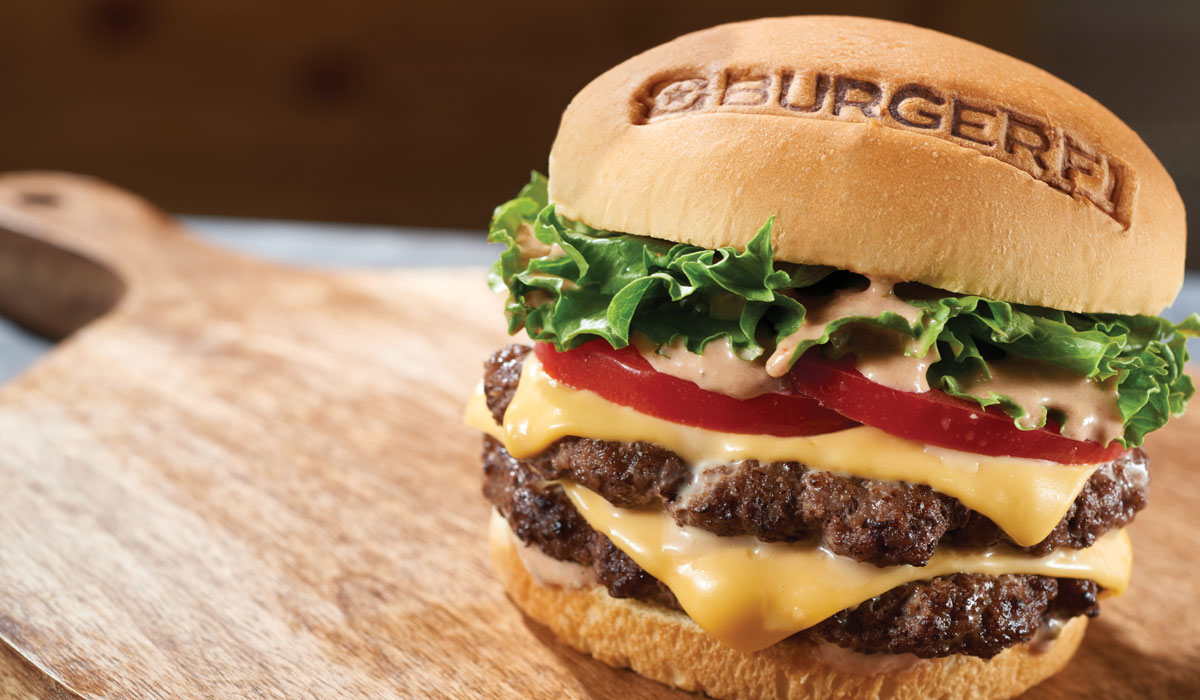Change has come quick and frantic for BurgerFi over the past year. It went public in December and “headed right into the storm” of what CEO Julio Ramirez calls the toughest headwinds in his lifetime. Ramirez spent 26 years at Burger King, including 16 as a senior executive, co-owned fast casual Giardino Gourmet Salads, and helped Dunkin’ enter Brazil as a consultant. A journey that spans 17,000 (Burger King) to 17 stores (Giardino), with BurgerFi right in the center, he says.
“I think both of those experiences will be very helpful now in the new world that we’re working in,” Ramirez says.
That world for BurgerFi isn’t just about navigating COVID-19. Tuesday was Ramirez’s one-year anniversary with the company and also marked day one of BurgerFi’s life as “multibrand platform of premium casual restaurant concepts.”
It began with Tuesday’s announced $161.3 million purchase of Anthony’s Coal Fired Pizza & Wings from L Catterton, expected to close in Q4. CFO Michael Rabinovitch says it’s fair to assume BurgerFi’s acquisitions are “not going to stop there.” You only need to look at the fact L Catterton will emerge as one of the brand’s largest shareholders with the sale. “That is their business,” Rabinovitch says. “They have a core competency in the restaurant space; they have a core competency in identifying the appropriate strategic and financial targets. That’s going to be very interesting.”
It’s also important to view the deal’s structure, Rabinovitch says, which was essentially an all-equity deal and not a cash-out to Anthony’s shareholders. Rather, it’s an investment that accepts BurgerFi’s shares. “And then,” Rabinovitch says, “they’ll be driven by increasing the value of the combined entity.”
The total price was comprised of $33.6 million in common stock, $53 million in new junior non-convertible preferred equity, and the assumption of existing debt. Upon close, BurgerFi will take on $74.7 million in debt from Anthony’s, and L Catteron, which holds majority investments in Uncle Julio’s and Primanti Bros, and minority stakes in Chopt, Hopdoddy Burger Bar, and Noodles & Company, will receive nearly $87 million in stock. BurgerFi now has a significant shareholder that’s bought and sold dozens of restaurant brands (previous investments include Bloomin’ Brands, P.F. Chang’s, Edible, Cheddar’s Scratch Kitchen, Baja Fresh Mexican Grill, First Watch, and Caribou Coffee). Andrew Taub, managing partner at L Catterton, is set to join BurgerFi’s board.
Before getting too far ahead in the M&A space, though, Ramirez says BurgerFi needs to work on this marriage. “We’re very focused on executing this first one well, both in watching the unit economics and working together to see where we can support each other,” he says. “Because I think fewer things done well always fare better than things being all over the place.”
However, if the process runs smoothly, “I have no doubt in my mind,” Ramirez says of future acquisitions. “You can already begin to guess other premium categories [we] can get into.”
The vision for BurgerFi will be “America’s food, better done,” he adds. And that’s where the genesis behind the Anthony’s deal really begins.
“To state the obvious, two of the historically—and continue to be two of the biggest categories in terms of growth—burgers and pizza, just continue to grow overall share,” says Ian Baines, Anthony’s CEO.
With the deal, Baines moves into a role as CEO of the entire company, under executive chairman Ophir Sternberg, founder and CEO of Lionheart Capital. Ramirez will be the CEO and president of the BurgerFi brand, while Rabinovitch remains CFO. Patrick Renna will serve as president of the Anthony’s concept.
Baines holds more than 15 years of experience in leadership across multi-unit restaurants, including leading Cheddar’s, Smokey Bones, and UNO Restaurant Holdings.
Anthony’s was founded in 2002 and is headquartered in Fort Lauderdale, Florida, roughly an hour’s drive up I-95 to BurgerFi’s base in North Palm Beach.
There are currently 61 company-owned stores, including 28 in Florida; 12 in Pennsylvania; five in New York; eight in New Jersey; four in Massachusetts; two in Delaware; and one apiece in Rhode Island and Maryland. Anthony’s posted average-unit sales volumes of $2.276 million in 2019 on sales-per-square foot of $669 (stores are generally 3,200 square feet). Check average was $39.15 and unit-level operating margin 19 percent. Anthony’s grew its revenue at a compound-annual growth rate of 12 percent from 2011 to 2019.
The brand boasts a 25-item menu where alcohol mixed 15.9 percent pre-COVID. Anthony’s centers on a 900-degree coal-fired oven that gets food out quick and produces a “well-done” pizza with thin and crisp crust that’s not soggy—a differentiator from the “New Haven-style pizza” often associated with this cooking style. The pizza is lightly sauced and comes out of the oven smoking, with black spots and char on the edge and bottom. Coal-fired chicken wings, homemade meatballs, and a variety of sandwiches and salads also dot the lineup.
The wings in particular spawned a virtual concept in November 2020 called “The Roasted Wing,” which offers up garlic knots as well. The wings are marinated overnight with garlic and fresh herbs.
But perhaps most alluring to note from an investor’s perspective, Anthony’s developed a smaller footprint fast-casual model at 1,700 square feet that could provide more attractive returns on unit economics, Rabinovitch says.
In BurgerFi’s 116-unit footprint, there are only 22 company-run stores. Five to 10 more are planned in the next nine weeks and it’s going to play a key role in expansion moving forward. The chain plans to seed new markets, like Nashville, Atlanta, and Virginia, with corporate openings. “I’ve always said, the best way to attract franchisees is to open a restaurant in the area,” Ramirez says.
Still, BurgerFi has a strong deep history in franchising. And that’s where the smaller Anthony’s could come into play. “If we can marry the desirability that Anthony’s presents its customers, with an investment profile that’s attractive to a franchisee, we’re going to have something there,” Rabinovitch says of a potential franchising opportunity.
Both brands boast heavy presences in the Eastern Seaboard, especially Florida. And as noted, there’s synergy in the quality-first, differentiated nature of their classic, yet elevated offerings. “I think both chains are brands that millennials [look for] and are the next iteration and a step up from what people used to know in burgers and pizza,” Ramirez says. “And I think we are both premium brands in a similar stage of the brand evolution. Coming together, the opportunities could be endless, in both cost opportunities down the road, but even in things like future growth opportunities for franchisees, etc.”
Rabinovitch expects to realize some of those combined efficiencies next year. Things like third-party costs, legal, financial, insurance, and other organization bills that consolidation and scale will ease. The acquisition is expected to be accretive to earnings per share to common shareholders and EBITDA in 2022.
Rabinovitch says much of that value will stem from how leadership is divided. Ramirez’s team will focus on growth, while Baines will oversee execution.
BurgerFi is generating nearly 40 percent of its business today through digital mechanisms.
In Q2, systemwide same-store sales lifted 44 percent year-over-year, including 39 percent at company-run stores and 45 percent at franchises. It earned $17.3 million in digital sales in the period—a 12 percent increase compared to last year.
Customers can order pickup and delivery through the chain’s native website and app and from the largest third-party delivery providers in the marketplace, whether that’s from brick-and-mortar stores or ghost kitchens. BurgerFi exited Q2 with more than 25 ghost kitchens operating across the U.S. in partnership with REEF and Epic Kitchens and said then it expected to open 15–20 additional ones by the end of the year (there are currently 30 or so). About 70 percent of the delivery-only outlets were in markets where BurgerFi already had a streetside store.
The overall goal was to debut 25–30 company-run and franchise restaurants in 2021. As of August, there were more than 25 signed leases, 18 of which were under various stages of construction.
“We have a lot to offer Anthony’s in serving the customer, growing their market base, and increasing frequency and average ticket the way that we’ve had some success doing,” Rabinovitch says.
From the other side, he adds Anthony’s virtual brand “opens up an opportunity for us to figure out how we can access a broader market.”
“When you look at the two companies combined we’ll have a much larger EBITDA base, we’ll have a much larger shareholder base,” Rabinovitch says. “We’ll have an outstanding shareholder in L Catterton, which has incredible expertise in M&A. So we have a lot of really interesting roads ahead to travel together.”
Speaking further on L Catterton, Baines worked with the firm during his time at Cheddar’s and Anthony’s, which was acquired in 2015. “To be able to tap in as I’ve been able to tap in—to tap into their level of expertise and resources is incredibly helpful,” he says. It’s something that will aid BurgerFi’s next chapter as a multibrand company, from who it targets to how it integrates.
“This is the most fluid time the industry has ever been in and I think that both Ian and I are used to working in that environment,” Ramirez says. “We get juiced up by that. And we’re very excited about the future in front of us in spite of the challenges that we have.”






